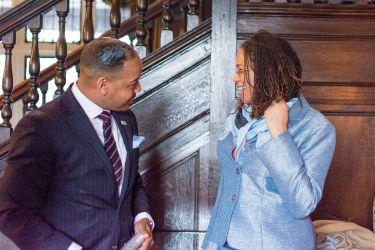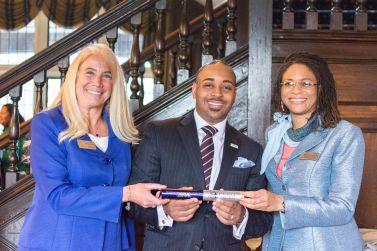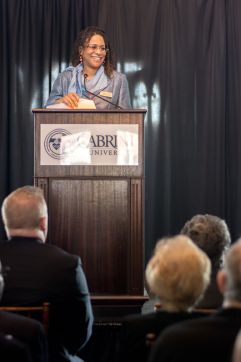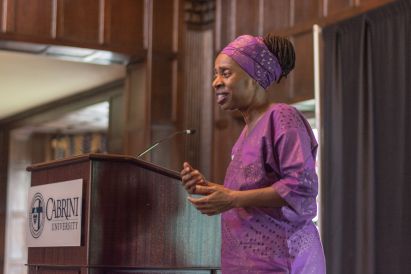Schools in under-privileged cities are often underserved and do not provide students with the proper tools they may need to be successful during and after school.
When Dr. Ayesha Imani, founder, CEO and Head of the School of Sankofa Freedom Academy Charter School in Philadelphia came to Cabrini she said, “Is this going to be the place that’s going to help us to break this cycle of injustice and some of the inequities that exist in education and in our world?”
On Mar. 27, 2017, Imani spoke in the mansion to launch Cabrini University’s education school’s new center called The Center for Urban Education, Equity and Improvement.
This center was founded and built by Dr. Ronald W. Whitaker II, director of district and school relations, in the school of education and Dr. Angela Campbell, assistant dean and professor, in the school of education.


When Cabrini launches something like a new building or a new center the event often involves a keynote speaker.
The Keynote Speaker
Imani, the keynote speaker, was an important influence in Campbell’s education. She was one of Campbell’s graduate school professors.
“I first met Dr. Ayesha Imani in graduate school,” Campbell said. “She was teaching a class on cultural responsive pedagogy and African centered education at Temple University and it was a dynamic class.”
“It was a very rigorous course.”
A lot of Campbell’s teaching style and mindset comes from Imani and how she was taught by her.
“I learned from her to hold the highest expectations of academic excellence and rigor in thinking,” Campbell said.
This is what makes Campbell hold the highest expectations of her students.

Campbell speaks highly of Imani, showing that she was a great influencer in her life.
Campbell said, “She challenged herself even as an instructor to always come over-prepared, ready to engage and push our thinking to the next level. So I model much of my own pedagogical philosophy and value systems off of those things that I experienced in her class. In addition to that I also did my dissertation study at Sankofa Freedom Academy in which I examined the influence of rites of passage classes on the adolescent girls’ gender identity, peer relationships and overall socialization in the school culture.”
“Doing my dissertation study in her institution influenced my thinking so when I came to Cabrini I immediately was attracted to Cabrini because of its mission. I was already steeped in a lot of the Freedom School principles around teaching and learning for the purpose of justice, learning for the purpose of freedom [and] teaching for the purpose of freedom,” Campbell said.
This is a big part of why Campbell chose Imani to be the keynote speaker at the launch of the Center for Urban Education, Equity and Improvement.
Although many would say that Imani was a great teacher to them, teaching was not always her main goal. It came unexpectedly.
“I didn’t start out wanting to be a teacher. I was a sociology major, but there was a strike in Philadelphia in 1972 and it went on for so long that the seniors, 12th graders, were in jeopardy of not being able to graduate at all and they wouldn’t have been able to go to colleges,” Imani said. “And so there was a call put out for college students, college professors, anyone willing to come and teacher so that school could be open for seniors.”
Imani took the opportunity and it ended up molding her career.

“I volunteered to go and I was all of 19 years old and I had a class with 50 students, teaching sociology and on the first day when I was there with those 50 students I said ‘this is it,’” Imani said. “This is what I was born to do.”
Imani said, “In that moment of working in that freedom school situation, it was clear to me that this was a way that I could make a difference and one of the things that I’ve loved about teaching is whatever your talents are, you dance, you write, you sing, you do poetry, whatever it is that you do, there’s room for you to do it in teaching in the classroom.”
Imani has impacted many of her students’ lives but she was able to see the impact that she had on Campbell during the launch.
“Looking at Dr. Campbell, she was a student of mine and wow,” Imani said. “To be able to look at her today and look at what she’s doing and the scale that she’s doing it on, I realized that, I got a chance to see her today but there’s so many students who are doing amazing things that I may never see.”
Imani said, “You don’t even know whose lives you’re touching and whose lives they’re gonna touch. And so, maybe I made a difference to Dr. Campbell and now she’s making a difference in the lives of other folk.”
Although Imani is no longer a teacher, she still finds ways to teach whenever she has the opportunity.
Imani said teaching is “my way of making a difference in the world.”
This is exactly what the Center for Urban Education, Equity and Improvement is trying to do: make a difference.
The Center’s Goals
The founders of the Center for Urban Education, Equity and Improvement are not only trying to make a difference in urban schools but also in the way people perceive urban schools and the way people define the word urban.
“Normally when you talk about anything urban, urban schools, children, communities, that is a code word for problems, degradation, black, Hispanic,” Whitaker said. “So with the center we’re presenting a counter narrative, ant-deficit framework into how we are engaging the students, the schools, the communities, the parents that we’re privileged to serve.”
The leaders of this center do not define the word urban because to them it is not just a certain type of environment or group of people. It is a lot broader than that.
“We’re not even defining what urban means to us.”
“Some people again, when you come in with ‘urban,’ you’re just thinking about black students, you’re not thinking about disabilities, you’re not thinking about students from the LGBT community you’re not thinking about the white underserved,” Whitaker said. “So, urban is extremely broad.”
“We were in a school last week in suburbia but they had urban realities so again the context really defines how we’re defining urban,” Whitaker said.
“I think that [defining urban] can be a dangerous thing because how you define normally correlates with how you engage so if you’re only defining something from one perspective you’re gonna engage it from another perspective,” Whitaker said. “But how you’re engaging is not what they need. It’s not the medicine that they need.”
The Center for Urban Education, Equity and Improvement is all about improving schools that are not able to perform at their best because of different circumstances.
Campbell said, “When I first heard Dr. Whitaker talk about not defining urban as a way to keep it intentionally nebulous almost so that the context and the needs in a given situation defines it and frames it and then we have opportunities to shape it, to reshape people’s narratives about education in urban spaces.”
“It means many different things,” Campbell said. “Why? Because there are many different people and scenarios and contexts that exist in what you typically would call heavily populated diverse spaces.”
During the keynote speech Imani talked about five main points that the center should focus on. These points were having a vision, breaking silence, disrupting the dominant discourse, having a call to action and telling stories.
The first point was having a vision and Campbell and Whitaker have a strong vision for the Center for Urban Education, Equity and Improvement.
“I envision it being a hub for cutting edge information and research, attracting people internationally to learn innovative and transformative approaches to teaching and learning in traditional and informal educational settings,” Campbell said.
The center is an opportunity for undergraduate students, graduate students, professors and anyone else who is willing and want to help bring change within the education in urban communities and communities with “urban realities,” no matter what field they are in.
“The vision is to be a change agent,” Whitaker said.
“The literature I would say 30, 40, 50 years, quite frankly we’ve been saying the same thing: ‘academic achievement gap,’ ‘there are problems in the community,’ ‘teachers,’ ‘we’re having a problem with retention,’ it’s all recycled,” Whitaker said. “They needed a new story and I believe that this center can present a new story.”
“We have the opportunity to sing a new song and that’s what we wanna do,” Whitaker said. “We wanna sing a new song that brings about the healing, brings about the change, brings about the liberation, brings about the hope that people have.”
The main goal of the center is to bring out change in school by working within the problem and not within the system.
Whitaker said, “We could deal with the system [but] we don’t have enough time to deal with all of the systemic issues, but what we can deal with are the ways in which they have been.”
“I would say they haven’t been trained the correct way, and I’m speaking of it from a broad perspective.”
“Regardless of what’s on paper, if it’s not working for students, it doesn’t work,” Imani said. “Right now we’re standing in this moment of hope and promise around the work of this center because we know that it might be the one.”


